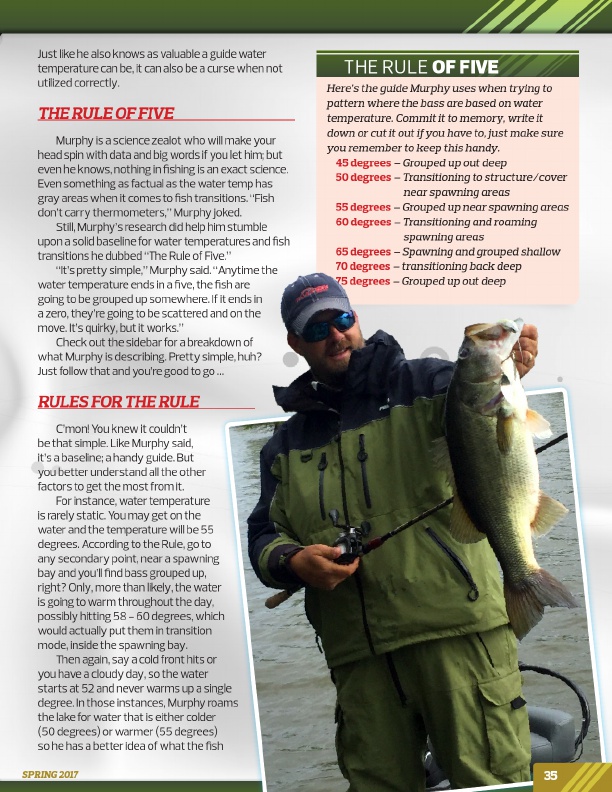
Just like he also knows as valuable a guide water temperature can be, it can also be a curse when not utilized correctly.
THE RULE OF FIVE
Murphy is a science zealot who will make your head spin with data and big words if you let him; but even he knows, nothing in fishing is an exact science. Even something as factual as the water temp has gray areas when it comes to fish transitions. “Fish don’t carry thermometers,” Murphy joked.
Still, Murphy’s research did help him stumble upon a solid baseline for water temperatures and fish transitions he dubbed “The Rule of Five.”
“It’s pretty simple,” Murphy said. “Anytime the water temperature ends in a five, the fish are going to be grouped up somewhere. If it ends in a zero, they’re going to be scattered and on the move. It’s quirky, but it works.”
Check out the sidebar for a breakdown of what Murphy is describing. Pretty simple, huh? Just follow that and you’re good to go …
RULES FOR THE RULE
C’mon! You knew it couldn’t be that simple. Like Murphy said, it’s a baseline; a handy guide. But you better understand all the other factors to get the most from it.
For instance, water temperature is rarely static. You may get on the water and the temperature will be 55 degrees. According to the Rule, go to any secondary point, near a spawning bay and you’ll find bass grouped up, right? Only, more than likely, the water is going to warm throughout the day, possibly hitting 58 - 60 degrees, which would actually put them in transition mode, inside the spawning bay.
Then again, say a cold front hits or you have a cloudy day, so the water starts at 52 and never warms up a single degree. In those instances, Murphy roams the lake for water that is either colder (50 degrees) or warmer (55 degrees) so he has a better idea of what the fish
SPRING 2017
THE RULE OF FIVE
Here’s the guide Murphy uses when trying to pattern where the bass are based on water temperature. Commit it to memory, write it down or cut it out if you have to, just make sure you remember to keep this handy.
45 degrees – Grouped up out deep
50 degrees – Transitioning to structure/cover
near spawning areas
55 degrees – Grouped up near spawning areas
60 degrees – Transitioning and roaming
spawning areas
65 degrees – Spawning and grouped shallow
70 degrees – transitioning back deep
75 degrees – Grouped up out deep
35